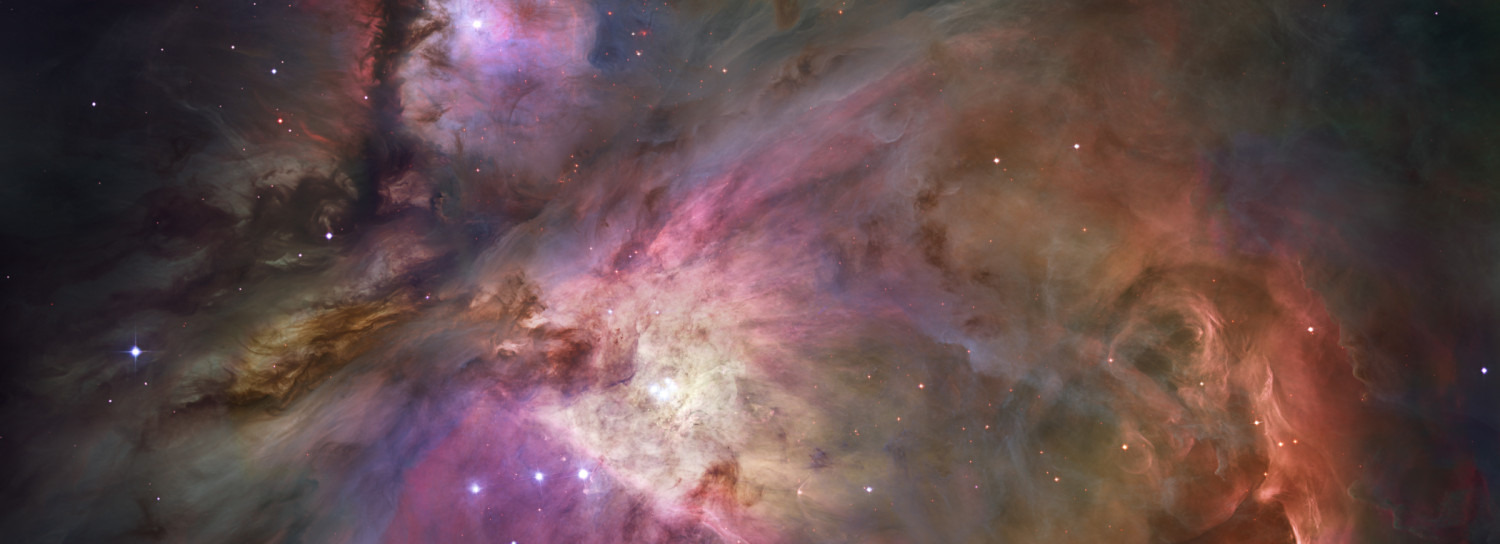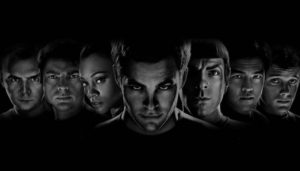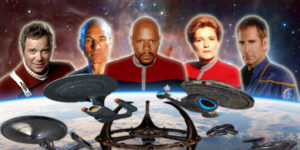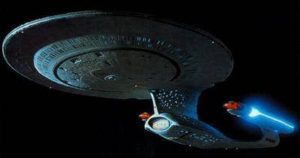Some of you may know I am a sci-fi nut. While my knowledge of television and film is not encyclopedic, it does spread over a wide range of shows and movies, and I can usually hang in a discussion on most tech and stories. Along with most of my generation, those born in the mid 70’s, my first major big screen exposure to the science fiction galaxy beyond our world was 1977’s Star Wars. While I remain a steadfast fan of the Galaxy Far, Far Away (especially the recent animated adventures), it was only the starting point for my sci-fi journey. There were two other staples of my sci-fi youth. The original Doctor Who, who from 1971 to 1981 was portrayed by the incredible Tom Baker, was carried by PBS where I lived in the early 1980’s, and I fell in love with the TARDIS and the saga’s of the Time Lords. I also had legitimate crushes on Leela and Romana and wanted my own K-9. And then in 1979 I discovered another sci-fi franchise, that would forever captivate me across multiple formats.
50 years ago today, the world of television and science fiction changed in a profound way. Star Trek premiered on NBC in 1966. Gene Roddenberry had sold it as a “Wagon Train to The Stars” or sorts, but it was so much more. Star Trek, focusing on the missions of the starship USS Enterprise under the command of firebrand James T. Kirk, never focused completely on action and interplanetary shootouts. Roddenberry set out to go where very few had dared to go before in television, straight on into tackling many of the hard, bitter issues of the turbulent 1960’s. Coining his own philosophical slogan for one his main characters, “Infinite Diversity in Infinite Combinations,” Roddenberry’s ship carried through with that statement. The Enterprise represented nearly the entire world — Europeans, American’s, African’s, Asian’s occupied the bridge of the Enterprise, with even our bitter Cold War enemies the Russians having a representative sitting at the weapons and navigational console. Off planet alien life was on the ship, and we routinely interacted with dozens of species from around the galaxy. The show addressed interracial tensions, sexism (it gave women equal status in Starfleet’s semi-military structure), the war in Vietnam, and inequalities on multiple levels. The television world’s first interracial kiss was feature on the show. Star Trek’s humanity had pushed through the problems its audience was facing, and finally united as one species, growing up to lead a vast Federation of world’s in peaceful exploration of the galaxy, while providing for common defense in times of need. Yes, occasional challenges did spring up, but we had figured out how to address them, and solve them, as one.
By the time I saw Star Trek: The Motion Picture in 1979 or 1980, Kirk, Spock, McCoy, Scotty, Chekov, Uhura and Sulu had become household names thanks to the shows three season run on NBC, and the subsequent cult following that had developed. TMP was not as flashy as Star Wars, and certainly not a good of a quality movie as The Empire Strikes Back, Lucas’ sequel, which came out in 1980. Even with my young eight year old mind, however, I picked up on what so many others already had — Star Trek was something different. Star Wars was pure escapism for me, with fantastic space battles, cool blasters and light sabers, magical powers from the Jedi, and the baddest bad guy of them all. Star Trek, on the other hand, seemed more real. Not only was it about US, a human race that had MADE IT through the tough times, but the ships, the tools, everything, seemed more grounded.
An entire generation of young people was inspired to take those sci-fi props and turn them into real products. Scientist and engineers all over the world have credited Trek with being the primary drive behind such devices as cell phones, video conferencing, tablet computers, energy weapons, 3D printers, holographic technology, even actual honest to god propulsion technologies. Yes, impulse engines and warp drive might actually lead to real engine tech down the road. Even shields and cloaking devices might also come to fruition, and transporter technology might also one day exist on a practical level.
I loved it. The original 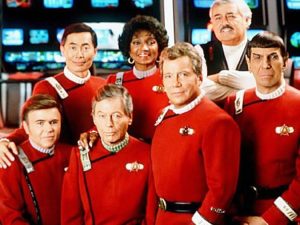 series crew, Kirk and Company, guided the Enterprise through six movies, their final voyage together being 1991’s “The Undiscovered Country.” By this time I was going off to college, but the series remained no less relevant. Over it’s film run, Star Trek had address genetic engineering, environmental and conservation issues, and with the 1991 entry, the after effects of a world transitioning from Cold War to a potentially hot peace. Despite the six films success, Star Trek was always a product best viewed on the small screen, where characters and long terms stories could be developed. And it was on the small screen that my fascination with Trek hit a new level in 1987. Star Trek The Next Generation premiered in September of that year, which was my freshmen year of high school. Roddenberry was at the production helm once more, with a multi-ethnic, multi-gender crew, and our former enemies (the Klingon’s in this case) were now our friends. Artificial life was even a member of the crew, in the form of an android who wanted to be human. The crew was, while still representing the ideals that Roddenberry put forth in the original 60’s show, vastly superior in many ways. Jean-Luc Picard, the captain portrayed by Royal Shakespearean actor Patrick Stewart, was just as easily able to talk himself out of a bad situation as Kirk had been to shoot himself out. The new Enterprise, the “D”, was incredible, and remains my second favorite Star Trek ship ever seen on screen. The first couple of years, in terms of stories, had their up and down moments, and it took awhile for the cast to gel. Heck, if it had debuted today, the show may have been cancelled after season one. But in the lat
series crew, Kirk and Company, guided the Enterprise through six movies, their final voyage together being 1991’s “The Undiscovered Country.” By this time I was going off to college, but the series remained no less relevant. Over it’s film run, Star Trek had address genetic engineering, environmental and conservation issues, and with the 1991 entry, the after effects of a world transitioning from Cold War to a potentially hot peace. Despite the six films success, Star Trek was always a product best viewed on the small screen, where characters and long terms stories could be developed. And it was on the small screen that my fascination with Trek hit a new level in 1987. Star Trek The Next Generation premiered in September of that year, which was my freshmen year of high school. Roddenberry was at the production helm once more, with a multi-ethnic, multi-gender crew, and our former enemies (the Klingon’s in this case) were now our friends. Artificial life was even a member of the crew, in the form of an android who wanted to be human. The crew was, while still representing the ideals that Roddenberry put forth in the original 60’s show, vastly superior in many ways. Jean-Luc Picard, the captain portrayed by Royal Shakespearean actor Patrick Stewart, was just as easily able to talk himself out of a bad situation as Kirk had been to shoot himself out. The new Enterprise, the “D”, was incredible, and remains my second favorite Star Trek ship ever seen on screen. The first couple of years, in terms of stories, had their up and down moments, and it took awhile for the cast to gel. Heck, if it had debuted today, the show may have been cancelled after season one. But in the lat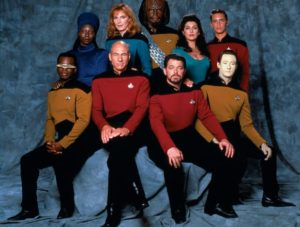 e 1980’s new shows were still given a few years to work out the kinks. And work them out The Next Generation did. TNG won 19 Emmy Awards, two Hugo’s, five Saturn’s and a Peabody award. In it’s seventh and final year, the show became the only syndicated show to be nominated for a Primetime Emmy Outstanding Drama. In this pre-DVR, heck, pre-VCR for me, era, The Next Generation was MUST SEE TV. I made time for it after school and after work, and if I missed the original air time I made sure I caught it on the re-run slot.
e 1980’s new shows were still given a few years to work out the kinks. And work them out The Next Generation did. TNG won 19 Emmy Awards, two Hugo’s, five Saturn’s and a Peabody award. In it’s seventh and final year, the show became the only syndicated show to be nominated for a Primetime Emmy Outstanding Drama. In this pre-DVR, heck, pre-VCR for me, era, The Next Generation was MUST SEE TV. I made time for it after school and after work, and if I missed the original air time I made sure I caught it on the re-run slot.
Roddenberry himself passed away in 1991, shortly before the release of “The Undiscovered Country” and several years into The Next Generation. His involvement beyond year one of TNG declined steadily, and some would say that might have been a good thing. His vision of the future, while providing a bedrock foundation, was averse to conflict. And as the new show runners knew, conflict was a source of many a storyline. But without Roddenberry, of course, there would be no Star Trek. “The Great Bird of The Galaxy” will always and forever be watching over the Federation and it’s universe.
The Next Generation spawned THREE spin-off shows: Deep Space Nine, which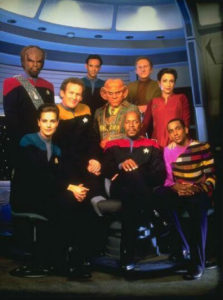 opened up the Federation to a multi-season war arc with a foreign power called the Dominion (and dealt with issues such as terrorism at length), Voyager, which sent a small, lone Starfleet vessel across the galaxy and watched as they tried to find their way home, and finally, Enterprise. Enterprise was actually a prequel series, starring Scott Bakula of Quantum Leap fame as Captain Jonathan Archer. By the time Enterprise hit the air in 2001, our world had
opened up the Federation to a multi-season war arc with a foreign power called the Dominion (and dealt with issues such as terrorism at length), Voyager, which sent a small, lone Starfleet vessel across the galaxy and watched as they tried to find their way home, and finally, Enterprise. Enterprise was actually a prequel series, starring Scott Bakula of Quantum Leap fame as Captain Jonathan Archer. By the time Enterprise hit the air in 2001, our world had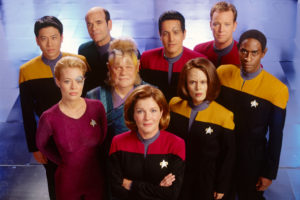 changed vastly. Recording technology had grown leaps and bounds, the INTERNET had been born and was starting to come of age, and social media was developing. And the lifespan of a TV show that suffered from lower ratings was dramatically lower. Enterprise was cancelled after only four seasons, rather
changed vastly. Recording technology had grown leaps and bounds, the INTERNET had been born and was starting to come of age, and social media was developing. And the lifespan of a TV show that suffered from lower ratings was dramatically lower. Enterprise was cancelled after only four seasons, rather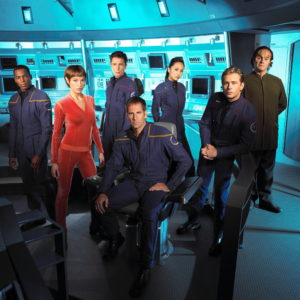 than the now traditional seven for a Trek show, just as it was hitting it’s stride.
than the now traditional seven for a Trek show, just as it was hitting it’s stride.
I can’t state enough how much Star Trek has impacted my life. If perhaps I had been less…lazy with my math and real world technical skills, maybe I would have charted a course into the sciences. As it is, I am a geek/nerd now, with a legitimate interest in science, astronomy and space ship technology that is something I intend to use and build on during the third phase of my life. Star Trek is also a unifying factor with 3/4’s of my household. Much like myself, my wife Brenda would catch The Next Generation in high school and college, and has always enjoyed the shows and movies. She wasn’t a big fan of Deep Space Nine, but small things like that can be overlooked in a healthy relationship. My older daughter, Piper, has grown up with a healthy respect for sci-fi, fantasy and magic, and recently has fully embraced The Next Generation and Enterprise on Netflix. We watch many episodes together. We also have all enjoyed the JJ Abrams led resurgence, starting in 2009 with the new “Star Trek” film. Some Trekkies and Trekkors can’t stand the new ‘verse that Abrams and his crew created. I, and my family, are fine with it.
Over the last few years the internet and plunging costs for both digital video cameras and processing software have helped fuel another Star Trek industry — the fan produced film. There are several outstanding entries, some of which include high quality acting professionals, such as Star Trek Renegades and Star Trek: Continues, and top notch special effects, like Axanar. Earlier this year, CBS and Paramount, who own the TV and film rights, respectively, to Star Trek, sued Axanar for infringement. The suit is still pending, and the studios created more ill will with a set of guidelines for fan films that seemed draconian to many who grew up in the internet age. The lawsuit may have effected the box office take for the latest film entry, “Star Trek: Beyond” which is by far the best entry in the JJ Abrams Star Trek series.
In January CBS will premiere, Star Trek Discovery on it’s online platform. I have very high hopes for this series, even if it is kind of crazy I have to pay $6.99 a month to access a network that shows most of their stuff FOR FREE OVER THE AIR. I will probably do it, however, since the show has top notch Trek talent running it.
50 years later, one thing is certain. Star Trek has a lot of dilithium left in the warp core, and many lights years left to travel.
Second star to the right, and straight on till morning.
